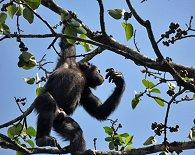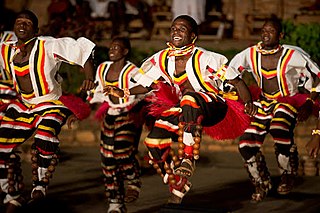Related Research Articles

The chimpanzee, or simply known as the chimp, is a species of great ape native to the forests and savannahs of tropical Africa. It has four confirmed subspecies and a fifth proposed one. When its close relative the bonobo was more commonly known as the pygmy chimpanzee, this species was often called the common chimpanzee or the robust chimpanzee. The chimpanzee and the bonobo are the only species in the genus Pan. Evidence from fossils and DNA sequencing shows that Pan is a sister taxon to the human lineage and is thus humans' closest living relative. The chimpanzee is covered in coarse black hair, but has a bare face, fingers, toes, palms of the hands, and soles of the feet. It is larger and more robust than the bonobo, weighing 40–70 kg (88–154 lb) for males and 27–50 kg (60–110 lb) for females and standing 150 cm.

Primates are the members of a diverse order of mammals. They are divided into the strepsirrhines, which include the lemurs, galagos, and lorisids, and the haplorhines, which include the tarsiers and the simians. Primates arose 85–55 million years ago first from small terrestrial mammals, which adapted to living in the trees of tropical forests: many primate characteristics represent adaptations to life in this challenging environment, including large brains, visual acuity, color vision, a shoulder girdle allowing a large degree of movement in the shoulder joint, and dexterous hands. Primates range in size from Madame Berthe's mouse lemur, which weighs 30 g (1 oz), to the eastern gorilla, weighing over 200 kg (440 lb). There are 376–524 species of living primates, depending on which classification is used. New primate species continue to be discovered: over 25 species were described in the 2000s, 36 in the 2010s, and six in the 2020s.

Technology is the application of conceptual knowledge for achieving practical goals, especially in a reproducible way. The word technology can also mean the products resulting from such efforts, including both tangible tools such as utensils or machines, and intangible ones such as software. Technology plays a critical role in science, engineering, and everyday life.

The bonobo, also historically called the pygmy chimpanzee, is an endangered great ape and one of the two species making up the genus Pan. While bonobos are, today, recognized as a distinct species in their own right, they were initially thought to be a subspecies of Pan troglodytes, due to the physical similarities between the two species. Taxonomically, the members of the chimpanzee/bonobo subtribe Panina—composed entirely by the genus Pan—are collectively termed panins.

The Israelites were a group of Semitic-speaking tribes in the ancient Near East who, during the Iron Age, inhabited a part of Canaan.

The genus Pan consists of two extant species: the chimpanzee and the bonobo. Taxonomically, these two ape species are collectively termed panins. The two species were formerly collectively called "chimpanzees" or "chimps"; if bonobos were recognized as a separate group at all, they were referred to as "pygmy" or "gracile chimpanzees". Together with humans, gorillas, and orangutans they are part of the family Hominidae. Native to sub-Saharan Africa, chimpanzees and bonobos are currently both found in the Congo jungle, while only the chimpanzee is also found further north in West Africa. Both species are listed as endangered on the IUCN Red List of Threatened Species, and in 2017 the Convention on Migratory Species selected the chimpanzee for special protection.
The origin of language, its relationship with human evolution, and its consequences have been subjects of study for centuries. Scholars wishing to study the origins of language must draw inferences from evidence such as the fossil record, archaeological evidence, contemporary language diversity, studies of language acquisition, and comparisons between human language and systems of communication existing among animals. Many argue that the origins of language probably relate closely to the origins of modern human behavior, but there is little agreement about the facts and implications of this connection.

A pack hunter or social predator is a predatory animal which hunts its prey by working together with other members of its species. Normally animals hunting in this way are closely related, and with the exceptions of chimpanzees where only males normally hunt, all individuals in a family group contribute to hunting. When hunting cooperation is across two or more species, the broader term cooperative hunting is commonly used.

Richard Walter Wrangham is an English anthropologist and primatologist; he is Professor of Biological Anthropology at Harvard University. His research and writing have involved ape behavior, human evolution, violence, and cooking.
Animal culture can be defined as the ability of non-human animals to learn and transmit behaviors through processes of social or cultural learning. Culture is increasingly seen as a process, involving the social transmittance of behavior among peers and between generations. It can involve the transmission of novel behaviors or regional variations that are independent of genetic or ecological factors.

The Ugandan red colobus or ashy red colobus is an endangered species of red colobus monkey, recognised as a distinct species since 2001. There is disagreement however over taxonomy with many considering the Ugandan red colobus to be a subspecies. The Ugandan red colobus is an Old World monkey which is found in five different locations across Uganda and Tanzania.
Monogamy is a relationship of two individuals in which they form an exclusive intimate partnership. Having only one partner at any one time, whether that be for life or whether that be serial monogamy, contrasts with various forms of non-monogamy. More generally, the term is used to describe the behavioral ecology and sexual selection of animal mating systems, referring to the state of having only one mate at any one given time. In a human cultural context, monogamy typically refers to the custom of two individuals, regardless of orientation, committing to a sexually exclusive relationship.
The Kasekela chimpanzee community is a habituated community of wild eastern chimpanzees that lives in Gombe National Park near Lake Tanganyika in Tanzania. The community was the subject of Jane Goodall's pioneering study that began in 1960, and studies have continued ever since, becoming the longest continuous study of any animals in their natural habitat. As a result, the community has been instrumental in the study of chimpanzees and has been popularized in several books and documentaries. The community's popularity was enhanced by Goodall's practice of giving names to the chimpanzees she was observing, in contrast to the typical scientific practice of identifying the subjects by number. Goodall generally used a naming convention in which infants were given names starting with the same letter as their mother, allowing the recognition of matrilineal lines.

The western chimpanzee or West African chimpanzee is a Critically Endangered subspecies of the common chimpanzee. It inhabits western Africa, specifically Côte d'Ivoire, Guinea, Liberia, Mali, Senegal, Ghana, Guinea-Bissau, but has been extirpated in three countries: Benin, Burkina Faso, and Togo.
Amba is a Bantu ethnic group located on the border area between the DRC and Uganda south of Lake Albert in the northern foothills of the Rwenzori Mountains. On the Uganda side, they are found in Bundibugyo District. On the Congolese side, they are located in the Watalinga and Bawisa subcounties of Beni, South Kivu. Numbering 42,559 on the Uganda side in the 2014 census and 4,500 on the Congolese side according to a 1991 SIL International estimate, Ethnologue lists their total population as 40,100. Agriculturalists, the Baamba traditionally cultivate plantains, millet, maize, sweet potatoes, peanuts, rice, coffee, cotton, and cassava, while raising goats and sheep. The Baamba practice Christianity.
Basic requirements of individual primates include obtaining food, avoiding predators, and reproducing. When these basic requirements are best pursued in the company of others, groups will form. Multi-male groups, also known as multi-male/multi-female, are a type of social organization where the group contains more than one adult male, more than one adult female, and offspring. This structure is characterized by group living, polygynandrous, and strong reproductive competition among males, which could result in an uneven division of male reproductive success. There are no stable heterosexual bonds as both males and females have a number of different mates. Multi-male groups are common among semi-terrestrial primates, like savanna baboons, macques, colobus and some New World monkeys.

Sexual swelling, sexual skin, or anogenital tumescence refers to localized engorgement of the anus and vulva region of some female primates that vary in size over the course of the menstrual cycle. Thought to be an honest signal of fertility, male primates are attracted to these swellings; preferring, and competing for, females with the largest swellings.
Vernon Reynolds is a British biological anthropologist known for his research on chimpanzee behavior and as founder of the Budongo Conservation Field Station. He has been described as "...one of a trio of pioneers who founded field studies of chimpanzees in the 1960s."
Grace Bantebya Kyomuhendo is a Ugandan professor of Women and Gender Studies, advocate for gender equality, social transformation and respect for women's rights. She is also a social anthropologist, feminist and social norms researcher and a lecturer at Makerere University. She and Marjorie Keniston McIntosh co-authored a book called Women, Work and Domestic Virtue in Uganda 1900-2003 which won the Aidoo-Snyder Prize.

Orunyege-Ntogoro is a traditional dance from the Bunyoro and Tooro kingdoms in western Uganda. It is a courtship dance that involves the use of rattles (ebinyege) and rings (entogoro) to produce rhythmic sounds and movements. The dance is performed by young men and women who seek to attract and impress potential partners for marriage.
References
- ↑ Gates, Henry Louis Jr.; Akyeampong, Emmanuel Kwaku (2012). Dictionary of African biography. Oxford: Oxford University Press. ISBN 9780195382075. OCLC 706025122.
- ↑ Boesch, Christophe; Boesch-Achermann, Hedwige (2000-04-06), "Chimpanzee and human evolution", The Chimpanzees of the Taï Forest, Oxford University PressOxford, pp. 258–276, doi:10.1093/oso/9780198505082.003.0011, ISBN 978-0-19-850508-2 , retrieved 2023-12-02
- ↑ Tshimba, David Ngendo (June 2020). Society against state or state against society? the unfolding of violence in contemporary Uganda's Rwenzori region (Thesis). ISSN 1021-8858.
- ↑ Childs, S. Terry (1998), "'Find the ekijunjumira': Iron mine discovery, ownership and power among the Toro of Uganda", Social Approaches to an Industrial Past, Routledge, doi:10.4324/9780203068922-15, ISBN 978-0-203-06892-2 , retrieved 2023-12-02
- ↑ Childs, S. Terry (January 1998). "Social Identity and Craft Specialization among Toro Iron Workers in Western Uganda". Archaeological Papers of the American Anthropological Association. 8 (1): 109–121. doi: 10.1525/ap3a.1998.8.1.109 . ISSN 1551-823X.